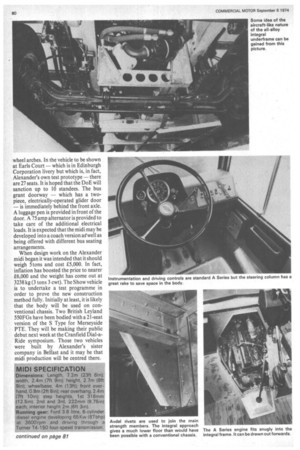Alexander goes for the double
Page 81

Page 82

If you've noticed an error in this article please click here to report it so we can fix it.
Integral midi-bus and new dual purpose body announced
By Martin Hayes
WITH THE announcement today of two major new models — an integral mid ibus and a dual-purpose coach body — W. Alexander (Coachbuilders) Ltd seems set to have a guaranteed crowd round its Earls Court show stand. And it will be well deserved, too. Coming only a year after the considerable engineering effort of bodying Ailsa's frontengined double-decker, the new models are particularly impressive. The midibus, known as the S Type, bristles with technical innovation and could be only the forerunner of a whole series of integral psvs. The T Type dual-purpose body, intended as an eventual replacenent for the venerable Y type has Hear potential for bus, express and uxury touring coach work.
Like many other coachbuilders, klexanders have looked at the growing nidi market and concluded that they hould be competing in it. The vehicle hey have announced today is an ntegral of all-alloy construction. The lecision to go integral was prompted by he desire to reduce floor height to the Dwest possible level. The first model uses Ford A series running units; both Bedford VAS and British Leyland Terrier are possible sources of power units) and achieves a floor height of 0.8m (2ft 6in). This is about 150 mm (6 in) less than would have been possible with a conventionally-bodied A series chassis. In the S Type it has been the intention to use as many standard Ford parts as possible. While full Ford warranty is not possible this should ensure that spare parts are easy to obtain. Operators who are not existing Alexander customers will buy the ,bus through S & N Motors, the Scottish Ford main dealers.
The subframe which carries the engine, transmission, suspension and steering is constructed from 430 mm (17in) deep 1-section continuous transverse members. These are made of highstrength light alloy material and are connected to the longitudinal members by Avdel rivets.
Fore and aft strength is provided by the body structure, itself all alloy and free from any widening. Exterior panels are mounted in the conventional fashion, with front and rear domes and the front wings in grp.
The engine sits about 76 mm (3in) lower than in the A series chassis but is otherwise unaltered. As well as using as many tried parts as possible the aim has been to use them in the same sequence as they are in the Ford-built vehicle. This should reduce in-service problems, it is claimed. Thus the Alexander wheelbase of 4 m (13ft) is exactly that of the A series, meaning that transmission, axles, prop-shaft and so on can be fitted in the same way. Axle and suspension mountings are in the same positions as on the Ford chassis.
Engine access for day-to-day maintenance is by means of a removable bonnet, while the engine can be removed by the unbolting of two crossmembers at the front. Probably the only major change to the Ford units is that effected to the steering column. In order to get the driver as far forward as possible and to minimize the space consuming front bonnet the steering column has been angled more steeply and slightly shortened. To suit this revised driving position the gear lever has had to be cranked and extended by a few inches and the handbrake has been moved higher.
The body has a completely flat floor apart from the intrusion of the rear wheel arches. In the vehicle to be shown at Earls Court — which is in Edinburgh Corporation livery but which is, in fact, Alexander's own test prototype — there are 27 seats. It is hoped that the DoE will sanction up to 10 standees. The bus grant doorway — which has a twopiece, electrically-operated glider door — is immediately behind the front axle. A luggage pen is provided in front of the door. A 75 amp alternator is provided to take care of the additional electrical loads. It is expected that the midi may be developed into a coach version as'well as being offered with different bus seating arrangements.
When design work on the Alexander midi began it was intended that it should weigh 5 tons and cost £5,000. In fact, inflation has boosted the price to nearer £6,000 and the weight has come out at 3238 kg (3 tons 3 cwt). The Show vehicle is to undertake a test programme in order to prove the new construction method fully. Initially at least, it is likely that the body will be used on conventional chassis. Two British Leyland 550EGs have been bodied with a 21-seat version of the S Type for Merseyside PTE. They will be making their public debut next week at the Cranfield Dial-aRide symposium. Those two vehicles were built by Alexander's sister company in Belfast and it may be that midi production will be centred there.
MIDI SPECIFICATION
Dimensions: Length, 7 2m (23ft 6in): width, 2.4m (7ft 9in); height, 2.7m (8ft 9in); wheelbase, 4m (13ft); front overhand, 0 8m (2ft 8in); rear overhang, 2.4m (7ft 10in); step heights. 1st 318mm (12.5m); 2nd and 3rd, 222mm (8.75in) each; interior height 2m (6ft 3m),
Running gear: Ford 3.6 litre, 6-cylinder diesel engine developing 65Kw (87 bhp) at 3600rprn and driving through a Turner T4-150 four-speed transmission.


























































































































































